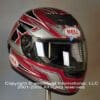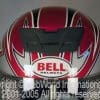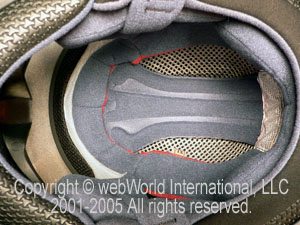Bell Helmets used to own the industry in a way that’s hard to understand by anyone who doesn’t remember.
There are dozens of excellent helmets to choose from today, manufactured to very high quality standards and meeting the world’s best safety standards.
I have no proof to back up this claim.
But I’d guess that just about any motorcycle helmet available today will offer protection levels that are far superior to anything back in the golden age of Bell Helmets.
The first real, honest-to-goodness full-face helmet I owned was a Bell.
I don’t remember the model name, but I do remember that it took seemingly forever to save up enough money to buy it.
My Bell was about 5 times the cost of the Kresge $19.95 special I was wearing at the time.
There isn’t a single company that owned the market and at the same time had the respect and cache as Bell Helmets back in the late ’70’s.
But like many other American companies, once the competition got smart and started their onslaught of innovative products, Bell faltered and became a shell (pardon the pun) of its former self.
Bell Helmets will probably never own the market again, what with so many established brands covering the world. But they do have a decent selection of helmets at very reasonable prices, so perhaps they’ll carve out a niche, helped along by nostalgia.
Just don’t expect the helmets to be made in the U.S.A. like Bells of old; this one’s made in China to Bell specifications.
We reviewed the open-face Bell Mag-8 about a year ago, and found it to be a well-made helmet with a very unique style and it left us with a good impression.
Bell recently released the full-face Sprint model shown here, so we decided to take a look to see how it compares to its peers.
The Bell Sprint is the only full-face motorcycle helmet offered by Bell as of this writing.
In addition to the Mag-8, the company also has a small line of motocross helmets and two open-face models that should be popular with the cruiser crowd.
We also purchased a cool-looking Bell Shorty with a flames motif and will be reviewing that soon.
Helmet Fit and Comfort
We get an extra thrill when a motorcycle helmet offers more value than its price would suggest. The Sprint lists for $159.95, but it can be found for around $139.00, making it a relative bargain.
The removable liner in the Sprint is very nicely made, with a higher quality appearance than some helmets we’ve used costing much more.
In fact, the Sprint’s liner compares favorably with the $650.00 AGV TiTech Rossi replica (review), in my opinion. Everything fits tight and the snaps are perfectly lined up, allowing the liner to be removed and replaced with little fuss.
This may sound like a no-brainer, but many helmet manufacturers either get it wrong or use cheap snaps that can literally crumble during their first use.
Especially nice is the use of a steel-colored mesh between the liner itself and a black open-weave mesh that lines the brow of the helmet, just under the eye opening. It gives the liner a very finished, quality appearance.
The black open-weave mesh is also used between the foam at the top of the helmet and the rider’s head.
Many helmets leave this area uncovered, which may improve air flow, albeit very slightly. But peering into a helmet and looking at Styrofoam always leaves me with the impression of cheapness.
The Sprint’s liner is comfortable, but certainly not the equal of the best, like the Shark RSR, Arai Quantum II orShoei RF-1000.
But helmet comfort isn’t necessarily a factor of cost; the Sprint’s liner feels very similar to the liner in the Suomy Extreme, for example.
If the Sprint had about 5 mm more padding in the liner and if the material had just a bit more nap, it would be equal to the best. Although I suppose the same could be said for many helmet liners…
The Sprint liner gets extra kudos though for its appearance and for the care that was taken in assembly.
The bottom edge of the helmet shell is also covered with a nice, thick vinyl bumper. This also serves as a sort of molding to hide the edge of the helmet’s liner where it meets the shell.
A vinyl-backed, permanently attached spoiler is fixed under the chin, and the vinyl is embossed with a checkered pattern that is repeated in a small crescent around the bottom of the neck.
All in all, an impressive job and way more than expected on a low-priced helmet.
Internal Shape
My feeling is that the Sprint will fit round shaped heads best and it fits true to size. See the wBWMotorcycle Helmet FAQ page for more information on fitting a motorcycle helmet and a discussion on head shapes.
Our size XL Sprint has an almost-round internal shape that is very slightly narrow at the middle, just about at the rider’s ears. We’d say that the shape is about half-way between the fit of a Vemar VSR (review) and a Shoei RF-1000 (review).
Face Shield
We’ve had some problems recently with helmet face shield issues.
It’s not clear if the manufacturers are specifying tighter tolerances for the fit around the sides of the helmet in the face shield rotating mechanism, requiring more force (thus more twisting action) to open.
Or perhaps the visors themselves are becoming thinner to save money or weight?
The problem is that some visors seem to be way too flexible. This is most noticeable when opening or closing the face shield and it twists dramatically as it’s being opened.
The Bell Sprint has more visor twist than we prefer, bending quite a bit before it actually moves. If the grab tab was in the middle of the visor, the flex might not be as noticeable.
Other than that, the face shield seals nice and tight against the helmet’s eye opening, which is a plus.
The sides of the face shield wrap around the outside of the helmet’s shell and cover the rotating mechanism.
Removal and replacement is easy and is accomplished by raising the visor to its uppermost setting and pulling on a lever on either side. Replacement and tinted face shields, cheek pads, chin curtains and other parts are available through Bell Helmets.
Noise Levels
This is the one area where the Sprint really suffers, in our opinion. We found the Sprint to be very noisy, and we’re not sure why.
Most helmet noises can be traced to air rushing over the vents or turbulence under the neck, but the Sprint just seems to be generally noisy in all dimensions.
The Sprint’s noise seems to be caused by air rushing around the entire helmet in a loud mid-level tone.
We’ve been experimenting with a couple of NOJ Quiet Rider helmet wind blockers (review) lately and we tried one on the Sprint to see if would reduce the noise levels, but it had only a minimal effect.
The bottom line here is that we think the Sprint is one of the more uncomfortable helmets we’ve tried with respect to noise levels.
Normally, a helmet will transmit less noise when the rider’s head is out in the open air flow, but the Sprint seems noisy anywhere except behind a full fairing.
Note that we always wear correctly fitted, high quality earplugs and an extra helmet liner when riding, and we strongly recommend that you always wear hearing protection also.
See the wBW Earplugs and Hearing Protection page for more information on choosing and wearing earplugs. Note that your experience with this helmet’s noise levels may be different, depending upon many factors, including your head shape, motorcycle configuration, prevailing winds and more.
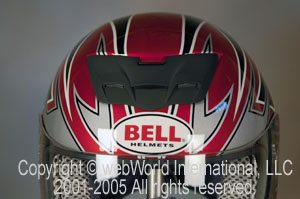
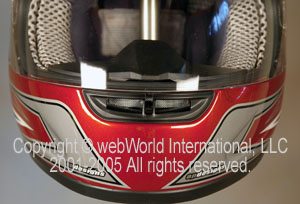
Ventilation
The Bell Sprint has a unique top venting system that works well. It’s narrower in height from top to bottom than other vents and the vent assembly is positioned farther forward (i.e., towards the brow) than most helmets.
It’s possible that the forward placement of the vent allows larger volumes of air to flow through a smaller opening when compared to other helmets.
A single flat lever in the back of the vent opens or closes three slits in the front. The vent has a positive seal and the lever is simple and intuitive to use.
The chin vent has a narrow tab that is easy to locate with gloved hands. The vent opens by pushing the lever down and closes by pushing it up.
There’s some mesh in back of the vent that appears to be the same type used in the helmet liner. It’s similar to the nylon mesh found in screen doors, perhaps with a slightly tighter weave.
Both vents are well made and add to the quality feel and appearance of the helmet. The Sprint also has two exhaust vents that are permanently open on the back of the helmet.
They’re covered with plastic trim and the vent holes underneath are also covered by the same steel-colored mesh, again adding to the overall feeling of quality.
Both sets of vents work well and flow a good quantity of air on to the rider’s face and head. The top vents channel the air through the liner and down on to the rider’s brow and head.
The chin vent flows air through two holes on either side of the back of the chin bar and on to the rider’s face.
We’ve noticed a trend with several helmets we’ve reviewed recently: manufacturers are adding vent openings on the back of the chin bar to flow air on to the rider’s face. This is good news for overheated riders and all we can say is that it’s about time.

Helmet Weight
This size XL Sprint weighs in at 1688 grams, or 3 pounds, 11-1/2 ounces.
This is a very reasonable weight and it puts the Sprint in good company, bracketed by the slightly heavier HJC CL-14 (review) (a direct competitor) and the Shoei X-11 (review) and Arai Quantum II (review) a couple of ounces lighter. Good company indeed!
See the wBW Motorcycle Helmet Weights page for a chart comparing the weights of every helmet we’ve ever reviewed.
Paint and Graphics
Here’s another category where the Sprint really stands out. Bell offers the Sprint in a variety of solid colors and patterns, and our “Red Multi” is very similar to the first Bell full-face helmet I purchased those many years ago.
It has a nice pattern and the finish has a thick clearcoat. I don’t anticipate any unforeseen problems with chipping or cracking.
Miscellaneous
The Bell Sprint meets both U.S. DOT and Snell approval; it has a composite fiberglass shell. Bell offers a five-year warranty on the helmet, which is commendable.
The Sprint also uses a D-ring attachment system and the strap includes a snap that keeps the loose end secure.
Conclusion
The Sprint is a very good helmet at a great price, let down only by high noise levels. If the helmet was quieter, it would certainly be one of the helmet bargains of the year.
It has very good to excellent quality and features that are unexpected at this price level.
Owner Comments and Feedback
See details on submitting comments.
From “C.L.” (8/10): “My first Bell helmet was a Star that saved my face from the bars after a tree jumped out and bit my bike on a narrow rocky narrow trail.
Well, it almost saved my face, as I still broke my nose on impact, but imagine the same crash with an open face helmet, which was pretty much the norm at the time It was a great helmet for sure.
I have the Sprint now and keep a good coat of wax on it to quiet it down at freeway speeds. I also wax the shield to help light rain bead up and clear off to the sides.”
From “J.O.” (5/10): “I bought a Bell Sprint helmet at the same time as my first bike, not wanting to drop a thousand dollars on gear as well in addition to the 3 grand for the machine. I was quite happy with it for a couple of months.
Then time and experience showed up the flaws.
The first was evident from the start: Noise. Really loud no matter what. The second didn’t show up right away, but I came to be disappointed with the air flow.
Far too much with the chin vent closed (makes for a cold face at 50 F) and not enough with everything open in warm weather (pretty sweaty at 8 F).
The final straw was the lining. The helmet fit great when I tried it on and for the first few months of ownership. Then the padding began to collapse, and the helmet was soon almost rattling around on my head. Game over.
The TZ-R I replaced it with served me well, but after two crashes and a pavement drop, an RF-1000 is on the way to take its place.”
From “R.A.”: “I read your report on this helmet today. I have used this helmet for two summers and two winters. I ride all year round. Here is my opinion of the helmet.
I purchased my helmet at Trev Deely HD in Vancouver,BC. They were having a test ride day and they had a nice yellow BMW 1100S in the used bikes that I fancied.
I bought the helmet, not the bike. I ride an ’89 Honda PC 800. Not ideal, but it was what I could afford and it has grown on me. Totally reliable, practical and great in all weather other than black ice (then what is?).
I have found the helmet to fit my head reasonably well, but a little discomfort around my ears. My size is small, hat size is 6 7/8 -7. Comparing fit to a Arai Quantum II, I found the Arai to fit my head considerably better.
Of course you are talking three times the price as well. I preferred the fit on the Arai to that of the Shoei that I tried on as well.
The color of my helmet is a flat white which I like with a spider web on the chin bar and flames along the sides. This is accomplished by light grey stenciling. It is different from all the other high gloss helmets, and gets lots of comments.
Here I thought it was rather conservative, and still affording better visibility awareness to the drivers around me than the standard black issue.
As for visibility, I find the shield opening a little small as my peripheral vision has a larger capacity than the helmet allows.
I do wear sunglasses most of the time and I have no issue once I enter then into the helmet, but I would love a drop down as you wrote about in the new Givi helmet.
I have found the helmet to be extremely noisy, changing the face shield has reduced the noise somewhat, but I believe it is caused by the flexing of the shield from the torquing it under goes from frequent opening and closing which is the case as my visor fogs up terribly.
I ride mostly with the chin vent open to help reduce the fogging and always keep the nose guard in place to cut down on fogging.
Fogging is not a problem at speed. Only at stop and idle. Summer riding is hot and venting is just adequate in my humble opinion.
The liner works well, but as you stated could be so much better with 5mm more. The helmet strap shed its locking feature about two months into daily use.
The helmet has been good in the rain as in not pouring in, but the seal around the shield was losing effect, I think because of the constant torquing it under went. Lots of tiny stress lines in the shield as well. The liner has worn from my 5 o’clock shadow showing up early as is the case for me.
It has worn well considering the daily wear and tear. I know it has a five year warranty, but I cannot see beyond this summer for this helmet. Too hot, too noisy, I do wear custom moulded ear plugs while riding, and the hold down strap is fraying.
The chin bar vent system remains open as the pin assembly holding the flap mechanism has dislodged itself and now remains permanently 3/4 open. Had to tape over in the bitter cold riding conditions.
Although the helmet is warm in summer, it was cold during near freezing and below. I used a balaclava to keep the cold from penetrating.
The top vents are closed, but in those temperatures cold air pours down over your face and to the point that my
contact lenses were drying out.
It is true that you get what you pay for and although the helmet does have many features, they are not well executed for the long haul.
I wore a Bell back in the mid sixties when I started riding, as you say they have improved for safety but not necessarily durability. I am looking into a new helmet so that is what got me here in the first place.
How would I recommend this helmet? 6 / 10. It is sustainable for less than average use.
Maybe I’m critical, but that’s what I’m spending my money on, and I don’t think the product holds up. And no I don’t want to find out if it does its job in an accident, DOT and Snell have approved it.
Me , I’ll take they’re word for it. I just want to be comfortable while wearing it. I don’t think I’ll be spending my money on Bell in the future unless they improve substantially.
Oh one last comment. There are virtually no dealers in Vancouver for Bell. Trev Deely HD I think is the only shop carrying them. This was what I encountered when looking for a shield replacement.
However the great people at Deely’s were kind enough to take a shield off a new helmet to bail me out. Although I don’t ride a HD, they have always been very helpful to me. Great customer service and support even for an old guy on a Honda. Ciao.”



